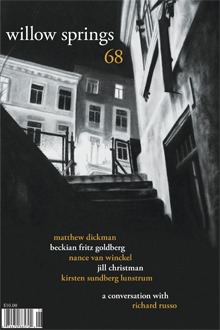
About Nance Van Winckel
Nance Van Winckel was editor of Willow Springs from 1990-1996. Her fifth collection of poems
is No Starling (2007, U. of Washington Press). She is the recipient of two NEA Poetry Fellowships as well as awards from the Poetry Society of America, Poetry, and Prairie Schooner. She is also the author of three collections of short fiction and the recipient of an Isherwood Fiction Fellowship for a work in progress. She lives near Spokane, Washington and teaches in the low-residency MFA Program at Vermont College of Fine Arts.
Her current project is something she calls pho-toems, a marriage of photographs and small bits of poetic
text. These have appeared in various literary journals, galleries, and shows.
A Profile of the Author
Notes on “Four Poems”
These poems are from a new book, entitled Pacific Walkers, that will be out in 2013 with the University
of Washington Press. The poems evolved from recalling my first “real” job: as a newspaper reporter. I was sent out to cover
a rash of unidentified corpses, John Does. Each poem I worked on seemed to call forth a next poem, and so on. I both love it
and hate it when this happens. I feel the poems invade me, take me over, make me theirs. The first piece I wrote about the job
was a little prose poem. It opened up the door.
THE JOB. I worked a week on the Bridal Desk and when I griped about it, the boss said, “Here then, Blondie, see if
you can get some legs under this.” And back in the last century I was a grateful person. Having scoffed at the brides and the
names of their laces, I was sent into a cold wind along a shoreline lashed by an icy froth and a third then a fourth John Doe
collected in black plastic bags and put in a black truck and me taking notes while the collector shook his head, saying, “Ain’t
no story here. There’s only one way to spell dead. Stand back.”
The two snaps of his green rubber gloves pulled on. He has a tag to attach to the dead man’s toe, but no toe. One
ankle but no foot. The collector says, “For someone who didn’t add up to much, this guy has quite the big number.” I write it
down. No one likes my story. I don’t like my story. In ten minutes I have to phone it in. What, per se, to jot? The filled-full
shadow becomes a shade.
I work for the paper. I can say this and flash a badge and walk into the cordoned-off places. I work for what I don’t
even know is itself about to die. The paper. The man’s big number sits beneath the small name—same as last week, as last year. I
jot: freedom fighter, according to the tattoo; Christ-lover, so claims the cross on its chain with its broken clasp. Loyal, yes,
to the end.
Notes on Reading
I’m always reading at least one book of poems, a collection of stories or a novel, and a nonfiction something. I go
back and forth between these in the course of a day. During my writing time, I take frequent breaks to read. Reading another poet gets my language synapses firing again. A new favorite collection of poems was Laura Kasishcke’s Space, in Chains. I loved how a poem of hers will start out in prose and then break into lineated lines, or vice-versa. Often right in the middle, the piece
morphs and moves from prose into poem. I liked how liberated that made the poems feel . . . as if they couldn’t be nailed down
to being one thing or another, which in turn seemed to go with the subject matter of the whole book, that transitoriness.
I’m also crazy about the poetry of Beckian Fritz Goldberg, Norman Dubie, Yusef Komunyakaa, and Mary Ruefle. I go back
to Transtromer frequently, and also to Wallace Stevens. In fiction I just read a wonderful short novel by Paula Fox called
Desperate Characters, and I’m now reading and thoroughly enjoying the collected short stories of William Maxwell
called All the Days and Nights. The Rings of Saturn by W.G. Sebald was a recent favorite book of nonfiction. I also pour over books of visual art: photography especially but also paintings and all sorts of collage, assemblage, and montage.


